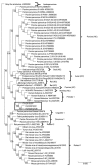Novel Parvovirus Related to Primate Bufaviruses in Dogs
- PMID: 29774829
- PMCID: PMC6004837
- DOI: 10.3201/eid2406.171965
Novel Parvovirus Related to Primate Bufaviruses in Dogs
Abstract
A novel protoparvovirus species, related genetically to human bufaviruses, was identified in dogs with respiratory signs. The canine bufavirus was distantly related to the well-known canine protoparvovirus, canine parvovirus type 2, sharing low amino acid identities in the nonstructural protein 1 (40.6%) and in the capsid protein 1 (33.4%). By screening collections of fecal, nasal, and oropharyngeal samples obtained from juvenile dogs (<1 year of age), canine bufavirus DNA appeared as a common component of canine virome. The virus was common in the stool samples of dogs with or without enteric disease and in the nasal and oropharyngeal swab samples of dogs with respiratory signs. However, the virus was not detected in nasal and oropharyngeal swab samples from animals without clinical signs.
Keywords: CIRD; bufavirus; dog; enteric infections; kennel cough; parvovirus; protoparvovirus; respiratory infections; viruses.
Figures


References
Publication types
MeSH terms
LinkOut - more resources
Full Text Sources
Other Literature Sources
Research Materials

